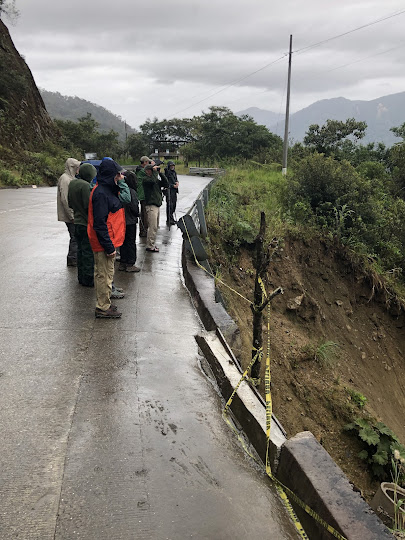Two Andean Mountain ranges split Ecuador with eastern and western cordilleras. From the southern edge of Ecuador we drove into the eastern range to Casa Simpson, the first of the Jocotoco Foundation lodges. The Foundation was created to protect vital ecological resources in Ecuador, including the relatively recently discovered Jocotoco Antpitta (a species of bird, not some sort of pit-digging ant trapper).
We started after some target rarities at high elevations on Cerro Toledo, where the wind is strong and the birds are few. Above tree line at about 10,000 feet AMSL, it’s not a setting that portends a high BPH (another technical birding term meaning Bird species Per Hour). But with persistence we (by which I mean our guide Sam) find one of the most sought-after hummingbird species, the Neblina Metaltail. You might wonder how a hummingbird could fly with a metal tail, but that’s just a euphemism referring to the gunmetal color of the tail on several hummingbird species.
According to the bird list Sue compiled of this outing (one of about 65 she has done so far, requiring meticulous attention to detail while at the same time having the sharpest get-on-the-bird-eyes in the group) we had a BPH of about 2, but this one was worth the trekking up and down the mountain-side - well, mostly up. Seems every time we headed down, we had to turn around and go back up.
Off this mountain we make our way to Casa Simpson, where hummingbird feeders quickly provide me with three more new hummer species. After a failed night slog to see a Screech Owl we set out early the next morning on what to become a rainy, bird-filled, 6 hour, 3 1/2 mile trek. A pretty good workout for our group of approaching-maturity adults. Jay points out that if 60 is the new 40, 80 is the new geezer.
A stop at a shelter included a relatively new trick to birding, attracting and feeding Antpittas (a rather specialized group of birds) with worms. This was the famous Jocotoco Antpitta (read about them here: https://www.worldlandtrust.org/species/birds/jocotoco-antpitta/) - pronounced “hokotoko” - a family of which has become so accustomed to being fed, that they appeared to be waiting for us “litrilly stamping their feet” in the words of our British guide. This I am making up, but they were clearly hungry and expecting a handout.
Travel around Ecuador can be tricky since landslides (“derrumbes” in Spanish or “YIKES!” in English), are commonplace and pretty much ignored by both the Highway Department and the trucks, cars, motorcycles, cows, and pedestrians that use the roads. But our excellent driver, Antonio, maneuvers our van expertly around these inconveniences that border on catastrophic rolls down vertiginous slopes.
Eventually we arrived at one the main reasons for the trip (other than a few weeks away from COVID and political news in the US), a private garden hosting the spectacular Spangled Coquette. Of course, as with the rare Jocotoco Antbird trek, this was also a chance to wash our shoes in the pouring rain as we climbed to the verbena garden and jostled among 15 or so people for views of not-the-Spangled Coquette. Until, miraculously, the rain stops and suddenly I hear alert and sharp-eyed Sue say “there!” And indeed “there” is a full-blown male SPCO (birder shorthand) and by some species of legerdemain I get a few decent photos.
Back to the Peru border tomorrow, over which a not-so-committed war was fought back in the 1990s.
All photos © C.S. Wood








No comments:
Post a Comment